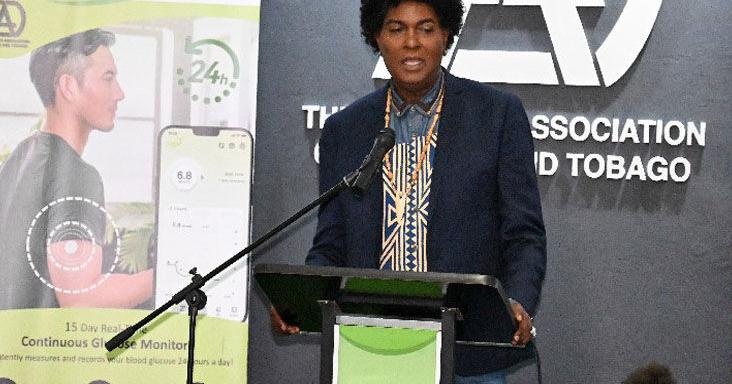TYPE 2 diabetes, more commonly seen in adults, is rising among children in Trinidad and Tobago.
Increasingly unhealthy lifestyles, such as overconsumption of fast foods and insufficient exercise, are also fuelling increased obesity in children, the Diabetes Association of Trinidad and Tobago (DATT) has said.
DATT is pleading for the adoption of healthier lifestyles in homes, as well as the removal of processed foods from the school-feeding programme.
The association yesterday launched an assistance programme for children aged five to 17 years, during which 27 children with type 1 diabetes received continuous glucose monitors (CGMs).
Type 1 diabetes was described as “rare” by DATT president Dr Andrew Dhanoo, who noted the condition in children was typically triggered by auto-immune illnesses.
DATT is currently looking to source CGMs for a further 100 children, with Dhanoo encouraging corporate sponsors to participate.
Type 2 diabetes is more common in adults and is usually as a result of lifestyle, based on diet and exercise.
Dhanoo said there has been an increase in children presenting with type 2 diabetes as he called on parents to take a “fresh foods” approach to their children’s nutrition.
He called for eating of healthier foods that are sourced and prepared from fresh ingredients, saying that processed foods could loosely be defined as food that can’t be prepared in the home.
Dhanoo noted the Ministry of Health had years ago removed soft drinks from the school-feeding programme.
He said, however, that many schools still offered “snacks” which were heavily sweetened with refined sugars or were processed.
Dhanoo recalled that studies last year showed some 23% of primary school pupils were obese, while 75% were overweight.
Obesity among children in primary school was around double the number found in secondary schools, and these children were at a much higher risk of developing type 2 diabetes, Dhanoo said.
He cited diet, as well as overall lifestyle, saying that more children were living very sedentary lives and were not getting enough exercise.
Obesity and a diet high in sugar and processed foods were exacerbating other risk factors in children, such as a family history of diabetes, Dhanoo said.
CGM ‘relief’
Parents and children who received CGMs yesterday expressed “relief” as the devices allow for “round-the-clock” monitoring of blood glucose levels.
Attached painlessly to an area such as the arm and held in place with adhesive, the monitors feed blood sugar data to a device such as a cellphone every few minutes.
It alerts users to low blood sugar, which is a challenge faced by people with type 1 diabetes who require insulin.
The CGMs assist with better meal planning and consumption, as well as allow users and caregivers increased comfort.
Several parents said the CGMs were a “blessing” as they would often be kept up at night worrying about their child’s blood sugar and constant monitoring.
The CGMs reduced “guessing” at mealtimes and allowed for meals to be consumed appropriately, they said.
Many said they felt more secure about their children’s lives as DATT would also be monitoring data from the 27 children who received CGMs.
Dhanoo said the monitors cost around $12,000 annually per child as he called on private businesses to join DATT’s sponsorship drive.
The CGMs distributed were sponsored by private entities, including the Rotary Club and designer Richard Young.
Anthony Anastascio, whose six-year-old daughter, Angeline, received a CGM, was high in praise of DATT.
He told the Sunday Express that even during yesterday’s event, Angeline’s CGM alerted him that her blood sugar was low, and she was given insulin.
As a result, Angeline’s meal was also timed a half-hour later while her blood sugar normalised.
He said his daughter accessed insulin through the Chronic Disease Assistance Programme (CDAP), but on occasion, it was not available via this facility and had to be purchased at private pharmacies.
Anastascio said it was sometimes difficult to find a supply when this occurred, and insulin cost around $200 per dose.
Angeline, who developed type 1 diabetes after the Covid-19 pandemic, said she was “very happy” and would also be learning how to monitor and manage her blood sugar.
Parent Penelope Bissoon said many parents would now be able to sleep better as some type 1 children were also prone to seizures.
Bissoon said children were the “future”, and she was “pleading” with the business community and private citizens to get involved and “help give these children the life they deserve”.
Dr Nicholas Maharaj, who was at the event, said CGMs were among the tools that help prevent emergencies, including the amputation of limbs, among children with diabetes.
Dhanoo said the Ministry of Health was also expected to soon introduce CGMs through the public system, and DATT hoped the resources would be available “sooner rather than later”.
He said DATT was also working on an “insulin pump programme”, which would create a “closed loop” in the monitoring and treatment of children with type 1 diabetes.

